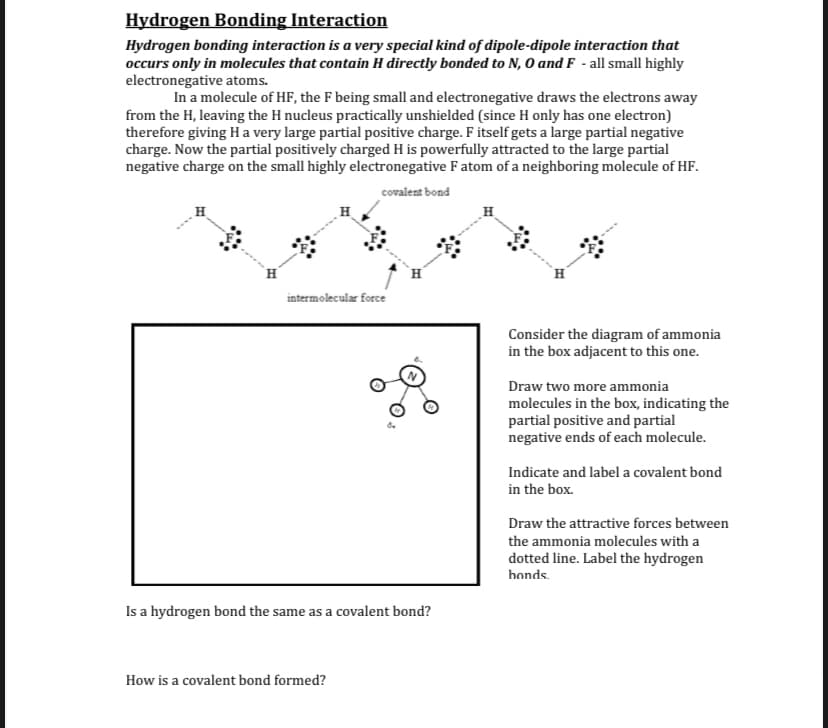Consider the diagram of ammonia in the box adjacent to this one. Draw two more ammonia molecules in the box, indicating the partial positive and partial negative ends of each molecule. Indicate and label a covalent bond in the box. Draw the attractive forces between the ammonia molecules with a dotted line. Label the hydrogen honds. Is a hydrogen bond the same as a covalent bond?
Consider the diagram of ammonia in the box adjacent to this one. Draw two more ammonia molecules in the box, indicating the partial positive and partial negative ends of each molecule. Indicate and label a covalent bond in the box. Draw the attractive forces between the ammonia molecules with a dotted line. Label the hydrogen honds. Is a hydrogen bond the same as a covalent bond?
Principles of Modern Chemistry
8th Edition
ISBN:9781305079113
Author:David W. Oxtoby, H. Pat Gillis, Laurie J. Butler
Publisher:David W. Oxtoby, H. Pat Gillis, Laurie J. Butler
Chapter3: Atomic Shells And Classical Models Of Chemical Bonding
Section: Chapter Questions
Problem 70P: Ozone (O3) has a nonzero dipole moment. In the molecule of O3 , one of the oxygen atoms is directly...
Related questions
Question
Please help answer this

Transcribed Image Text:Hydrogen Bonding Interaction
Hydrogen bonding interaction is a very special kind of dipole-dipole interaction that
occurs only in molecules that contain H directly bonded to N, O and F - all small highly
electronegative atoms.
In a molecule of HF, the F being small and electronegative draws the electrons away
from the H, leaving the H nucleus practically unshielded (since H only has one electron)
therefore giving Ha very large partial positive charge. F itself gets a large partial negative
charge. Now the partial positively charged H is powerfully attracted to the large partial
negative charge on the small highly electronegative F atom of a neighboring molecule of HF.
covalent bond
H
intermolecular force
Consider the diagram of ammonia
in the box adjacent to this one.
Draw two more ammonia
molecules in the box, indicating the
partial positive and partial
negative ends of each molecule.
Indicate and label a covalent bond
in the box.
Draw the attractive forces between
the ammonia molecules with a
dotted line. Label the hydrogen
honds.
Is a hydrogen bond the same as a covalent bond?
How is a covalent bond formed?
Expert Solution
This question has been solved!
Explore an expertly crafted, step-by-step solution for a thorough understanding of key concepts.
This is a popular solution!
Trending now
This is a popular solution!
Step by step
Solved in 2 steps with 1 images

Knowledge Booster
Learn more about
Need a deep-dive on the concept behind this application? Look no further. Learn more about this topic, chemistry and related others by exploring similar questions and additional content below.Recommended textbooks for you

Principles of Modern Chemistry
Chemistry
ISBN:
9781305079113
Author:
David W. Oxtoby, H. Pat Gillis, Laurie J. Butler
Publisher:
Cengage Learning

Organic Chemistry: A Guided Inquiry
Chemistry
ISBN:
9780618974122
Author:
Andrei Straumanis
Publisher:
Cengage Learning

Physical Chemistry
Chemistry
ISBN:
9781133958437
Author:
Ball, David W. (david Warren), BAER, Tomas
Publisher:
Wadsworth Cengage Learning,

Principles of Modern Chemistry
Chemistry
ISBN:
9781305079113
Author:
David W. Oxtoby, H. Pat Gillis, Laurie J. Butler
Publisher:
Cengage Learning

Organic Chemistry: A Guided Inquiry
Chemistry
ISBN:
9780618974122
Author:
Andrei Straumanis
Publisher:
Cengage Learning

Physical Chemistry
Chemistry
ISBN:
9781133958437
Author:
Ball, David W. (david Warren), BAER, Tomas
Publisher:
Wadsworth Cengage Learning,

Chemistry: The Molecular Science
Chemistry
ISBN:
9781285199047
Author:
John W. Moore, Conrad L. Stanitski
Publisher:
Cengage Learning